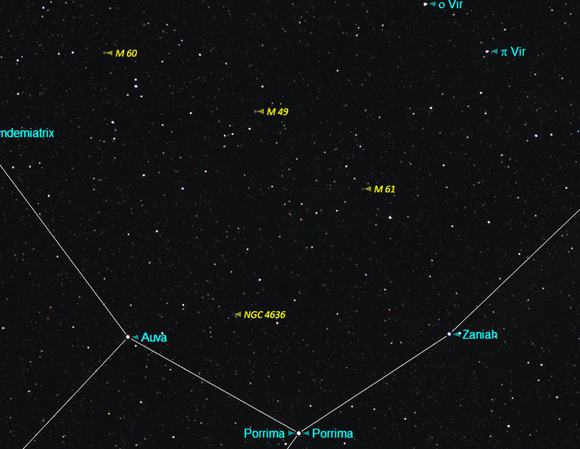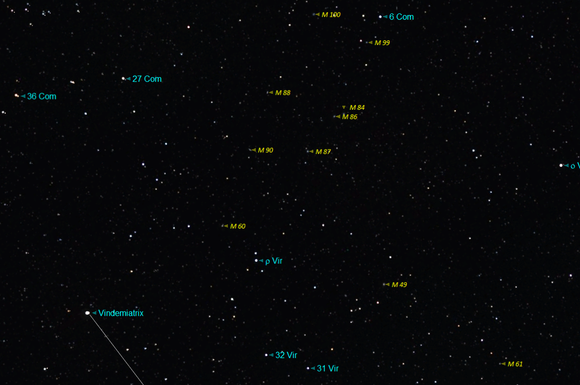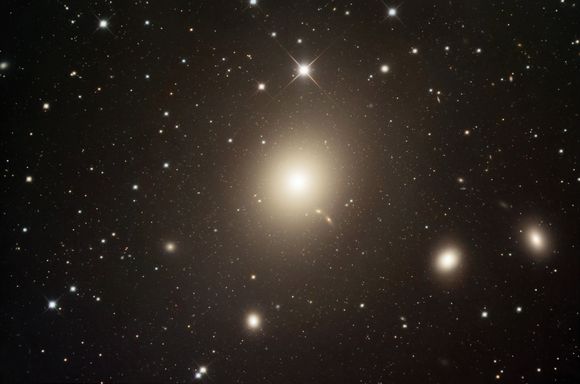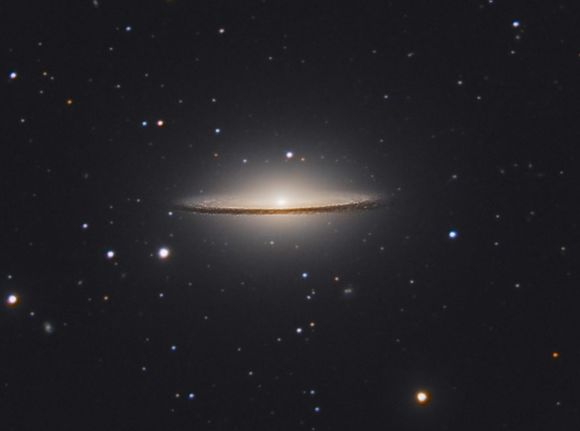April skies are not fully dark before 21:00 - 22:00hrs by which time many of the seasonal constellations associated with winter are on the verge of departing. Spring constellations occupy much of the sky to the south and east, of these, three are associated with the labours of Hercules; Cancer, Hydra and Leo (covered in The Lion and the Serpent.) Two further constellations; Virgo and Coma, occupy an area of the night sky where galaxies abound in great numbers, a window through which we can observe the wider local universe, in particular the Virgo super cluster of galaxies.

Artist's impression of Spica:
hot, massive, double-star system
distorted as they whirl around
each other every 4 days
Following the celestial Lion across the sky, Virgo, the Maiden becomes fully visible by mid - late April. Virgo ranks as the largest constellation of the zodiac and second largest in the sky overall after Hydra. It contains the first magnitude star, Spica (mag 0.97). Spica looks like one star, but it is at least two stars, both larger and hotter than our sun, orbiting only 18 million kilometres (11 million miles) apart. Their mutual gravity distorts each star into an egg shape, with the pointed ends facing each other completing a single orbit in only four days. The stars reside around 262 light years away and are at least 300 times more luminous than our Sun. Virgo contains 15 other named stars, the brightest of which are Porrima, Syrma, Vindemiatrix, Zaniah, and Zavijava. The outline of Virgo has been likened to that of a large distorted 'Y' shape, with Spica situated at the bottom of the leg
According to myth, one legend Virgo represents Demeter; mother goddess of Earth, whose daughter, Persephone, after being pierced in the heart by one of Eros’s love arrows, was forced to return to the underworld ruled by Hades, who instantly fell in love with her. Hearing the cries of her daughter, Demeter searched the world over without success, cursing the ground so that no crops would grow. Eventually Demeter learned of the whereabouts of Persephone and begged Zeus to free her. However Persephone was only allowed to return to Earth’s surface for six months in the year – spring and summer, descending back down into the underworld for autumn and winter, a reflection of when Virgo is visible in the sky.
The area of sky within and above the ‘bowl of Virgo’ (the 'Y') extending up toward Coma Berenices is known as the realm of the galaxies, a window on to the wider universe, through which we can view the Virgo and Coma galaxy clusters. Our own local galaxy group is an outlying spur of these clusters. The Virgo cluster lies some 40-60 million light years distant, with the more remote Coma galaxy cluster approximately 250- 300 light year distant.
Virgo contains eleven Messier objects: M49 - NGC 4472, M58 - NGC 4579, M59 - NGC 4621, M60 - NGC 4649, M6 - NGC 4303, M84 - NGC 4374, M86 - NGC 4406, M87 - NGC 4486, M89 - NGC 4552, M90 - NGC 4569 and M104 - NGC 4594, the Sombrero Galaxy.
Of these, M49, the 2nd brightest galaxy in the Virgo Cluster and first to be discovered by Charles Messier in February 1771, may be seen in 10 x 50 binoculars as featureless round fuzz, it remains structure less even in larger telescopes. Located around 53 million light years distant, it is an elliptical galaxy with a visual magnitude of 8.4. M49 contains over 5700 globular clusters and a super massive black hole with 565 million solar masses at its core.
M58 is a barred spiral galaxy with a magnitude of 9.6. It lies 62 million light years distant. M58 was discovered along with the elliptical galaxies M59 (48 million LY) and M60 (53 million LY) by Charles Messier in April 1779.
M61 is a face-on spiral galaxy, and one of the larger members. It has an apparent magnitude of 9.6 and is approximately 50 million light years distant. Six supernovae have been noted in M61 just in the last 100 years. M61 was not discovered by Messier, but by the Italian astronomer Oriani in May 1779. Messier noted it later in the same month.
M84 is a lenticular galaxy and resides in the inner core of the Virgo cluster. It has a visual magnitude of 9.1 and is approximately 58 million light years distant. It was discovered by Charles Messier in 1781
M86 is another lenticular galaxy approaching the centre of the Virgo Cluster from the opposite side to us. It was discovered by Charles Messier in March 1781. The galaxy has a visual magnitude of 8.9 and is about 57 million light years away.
Discovered by Charles Messier in 1781, M87 is a supergiant elliptical galaxy located near the centre of the Virgo Cluster. At magnitude 8.6, it is one of the brighter members and also one of the brightest radio sources known. M87 is one of the most massive galaxies in the local universe containing several trillion solar masses in a sphere 140,000 light years across. It lies 55 million light years distant. M87 has become famous for its central jet over 65,000 light years in length. Fast particles at almost the speed of light are interacting with strong magnetic fields emitting synchrotron radiation. The jet originates from a super massive black hole at the centre of the galaxy, the first to be directly imaged in April 2017.
M89 is another elliptical galaxy in Virgo. Messier discovered it in March 1781. It lies 50 million LY away and is mag 9.7. M90 is a fine looking spiral galaxy, but lies this side of the Virgo cluster around 31 million light years away. It has a magnitude of 9.6.
M104 is an unbarred spiral galaxy with a visual magnitude of 8.1 making it the brightest galaxy in Virgo, but not necessarily a member of the Virgo cluster. The approximate distance of 29.3 million light years puts it rather closer to us than the Virgo cluster members. It can easily be seen in amateur telescopes. The galaxy contains around 1,800 globular clusters. It was discovered by Pierre Méchain - Messier's colleague in March 1767 and later included in the Messier catalogue.
We shall look at the deep sky galaxies in Coma Berenices - next month.
Chart Credits - Stellarium, Starry Night Pro Plus, NASA, ESA -unless stated otherwise.
- Log in to post comments







